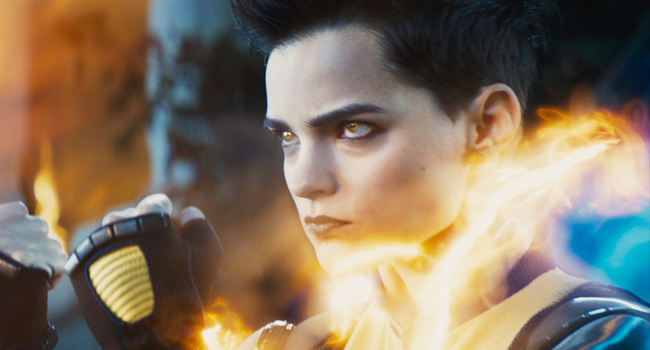
UPROXX’s Vince Mancini, in his Deadpool 2 review, has declared that the return of the Merc With A Mouth somehow delivers more than the original film against all the odds. That is to say, Ryan Reynolds once again successfully endears audiences through his admittedly annoying and over-the-top antihero with the help of a motley crew of more supporting characters than the first film. Deadpool’s continued success as an onscreen character remains remarkable — he intentionally pushes every button possible, simply because he can. And he doesn’t even do so to save the world, which is rather refreshing.
As audiences endure the final stretch ahead of the sequel, it’s worth reflecting upon the moment when the first Deadpool film truly began to click, and the character — Negasonic Teenage Warhead (played by Brianna Hildebrand) — who helped this happen. During the tail end of the exhilarating highway scene, Deadpool encounters Colossus and his mutant trainee. Wade, who can’t stand to be reprimanded by Colossus, attempts to fight him with disastrous results. One by one, Deadpool’s appendages turn to noodles, and yet, he persists. The resulting display is so absurd that even the humorless Negasonic, who functions as the film’s straight man, can’t help but laugh.
This scene was a delicious one, and the absurd moment in question followed the pair’s introduction, which saw Deadpool not only make a few wisecracks about her name (“What the sh*t? That’s the coolest name ever!”) but get judgy over teens’ notoriety for making sullen, mean comments while drowning in their own collective ennui. Here’s that moment for the rewatching.
This mutant, whose real name is Ellie Phimister, is an utter delight, especially when she tells Deadpool (of his assumptions), “You got me in a box.” She’s messing with him, and he doesn’t get it at all, which is the inevitable case for most adults who attempt to level with their younger counterparts while forgetting how it felt to be a teen. She’s also unwilling to let Deadpool’s shenanigans affect her, which is why she later insists upon finishing a tweet before heading into battle on her own terms.
More importantly, her powers (at least in the first film) were indispensable to Deadpool’s victory, so he didn’t have much of a choice in waiting on her (despite sarcastically commenting upon it in the process). That’s because whereas Deadpool uses guns, grenades, and katanas, and he and Colossus are essentially indestructible, Negasonic’s got the offensive powers. She can actually generate the power of a warhead, which is one of the coolest powers to wield. Yet unlike how she would have simply been characterized by her power in an X-Men film (like Banshee, Angel, and so many others), Negasonic gets fleshed out more as a person for Deadpool.
Yet interestingly, Deadpool‘s screenwriters needed to essentially create this character — because while Negasonic is lifted from the X-Men comics, she’s a non-entity in print. As such, she was plucked out of relative obscurity by writers Rhett Reese and Paul Wernick and completely transformed. They revamped her power set to insert some actual “traditional” superpowers into the film. She was also chosen for her name, which was originally lifted from a Monster Magnet song. And whereas the comics merely gave her prophetic abilities, in the Deadpool film, she’s Colossus’ ultra-powerful protegee.
So while Negasonic Teenage Warhead was a cipher in the comics — known only for a few brief appearances, which saw her die multiple times, the latter of which drove Emma Frost a bit crazy — she was a blank slate through which the Deadpool writers could conjure up some baddassery. And although it’s often the case that deviating from source material angers legions of fans, all cinematic changes were welcome here. She’s the literal warhead, who can whip up massive explosions and zoom into action at a millisecond’s notice, before her opponents even realize what’s happening.
She’s also the polar opposite of Deadpool, who needed someone much more understated, deadpan even, to absorb his more abrasive personality aspects. That the writers had to deviate from the source material in order to find an acceptable character for Wade to bounce off of speaks volumes, and she who fits the bill is worthy of awe. And Negasonic was instrumental in the first film’s final battle, so, Deadpool needs her, but she really doesn’t need him. It’s a nice turn of events and one of several ways that the film subverted expectations.
Yet it’s hard to imagine Negasonic standing on her own in a movie. Or for that matter, Deadpool or Colossus. All three of them were integral parts of the superhero/antihero equation in the first film, and it’s clear that Deadpool still can’t stand on his own in the sequel. There’s nothing wrong with that — not every character can receive the standalone treatment like Marvel so often does, and even then, it’s obvious that none of the “standalone” films are anything other than ensemble films with standalone-geared titles.
As a movie, it’s doubtful that Deadpool could have easily glided to box-office glory without a stoic presence like Negasonic to counterbalance the titular character’s ridiculous ways. And it’s also nice to see her get her due in a major superhero vehicle (and its sequel), whereas she’d otherwise be completely ignored (or highlighted for only a few minutes, max) in an official X-Men ensemble. Could Negasonic hold her own in a standalone flick? Not unless we’re bringing back Charlie Chaplin-esque silent marvels, but she’s great at owning Wade Wilson by being herself.
